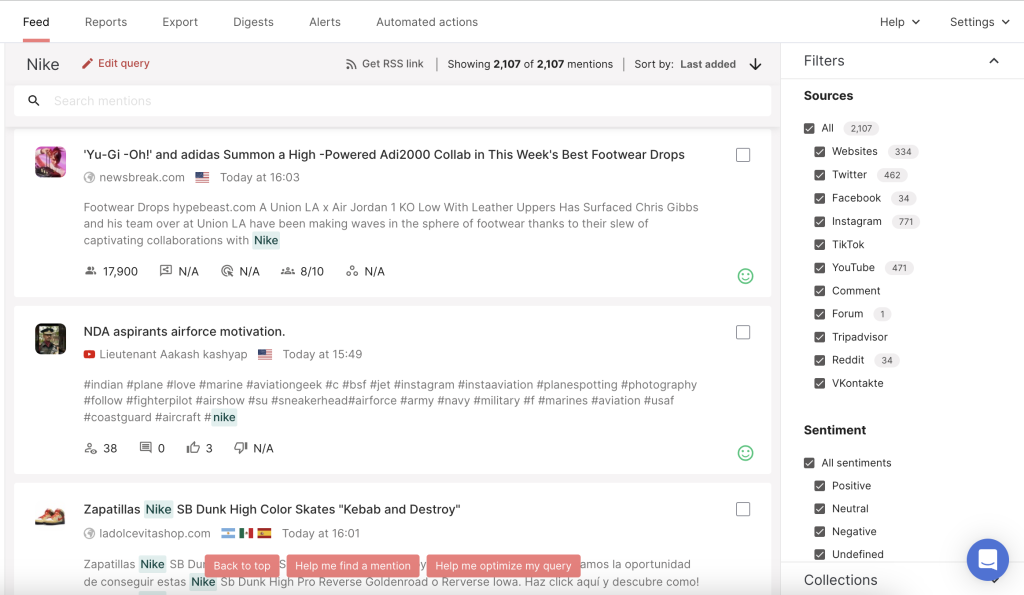Have you ever thought about brand reputation?
Taking care of your brand image is a day-to-day job. I fact, 85% of consumers trust online reviews as much as personal recommendations. Regrettably, some companies are not prepared to confront the reality and consider the opinions of their customers and clients. However, this is just as crucial as the sales procedure.
Moreover, without monitoring your reputation, establishing a lasting business is imposible. Sometimes a single misstep or a fabricated comment from competitors is sufficient to spread negative information about your company. This can result in the loss of trust from both existing and potential customers.
? Read Brand Reputation 101: Monitoring, Analysis, and Management Tools
There is an easy way to create the perfect reputation management strategy. In this blog we’ll go through its 5 crucial steps.
What is Reputation Management
Reputation management is the process of tracking and optimizing the image that your clients and buyers have of you. With the rise of email marketing and business promotion on social media and the internet in general, it has become much more difficult to keep track of the comments your users leave about you.
Furthermore, it is impossible to prevent people from expressing their opinions about you. And this is not the point. It is upon you to make sure to track what is going on and react accordingly. When these opinions are positive, they can have a beneficial impact on your personal and company’s reputation. However, when these opinions are negative, especially if they are unjustified, they can significantly harm your achievements.
Read 7 Ways to Protect Your Online Reputation

How to Create a Successful Reputation Management Strategy
Research says that 47% of Internet users around the world publish monthly reviews about a product, service, or company. This is a significant info that should serve as a baseline when initiating a strategy.
However, it is crucial to remember that generating fake positive reviews should never be an option. Users are well-aware of these fraudulent tactics and will inevitably expose them. On the other hand, if you lack reviews, it is advisable to request your customers to provide them. You can use emails or social media posts to ask for feedback and provide a link to the platform.
Consequently, you can expect a flurry of positive messages if your services were satisfactory, or a few comments that can serve as an impetus for enhancing your service quality. Genuine feedback is the most effective means of building a positive reputation today.
Read A Newbie’s Guide to SEO Reputation Management
Step 1: Track the mentions of your brand
First you need to learn how to track where and what users write about you. And this is fairly easy with a media monitoring tool like Determ. It tracks mentions of your brand from over 100 million online sources, in a single dashboard. In this way you can gather all the data about where exactly on the Internet your brand is present. This should be not only sites and pages on social networks, but also information about the presence of pages on forums, sites with reviews and other platforms.
If you’re selling physical products, then eBay and Amazon are your places to look for reviews. It is better to enter the brand name in different ways and even with errors, sometimes users may not write correctly.
This step is extremely important, because about 69% of buyers study reviews about the company they are going to make a purchase before buying.
Read A Simple Guide to Corporate Reputation Management
It is also essential to monitor bloggers and blogs. These sites frequently contain references to specific stores/companies that participate in reviews or articles. Moreover, bloggers on social media frequently share their opinions and experiences, which can be either favorable or negative. Although tracking them in reels or stories can be challenging, it is worth the effort.
It is crucial to monitor each of these channels to be able to respond promptly to negative feedback from your audience. This monitoring is not a one-time task but a continuous process that requires regular analysis. Some platforms may even require multiple daily checks. In such cases, Determ is a useful tool as it allows you to set real-time alerts that notify you instantly whenever your brand name is mentioned.
Read 10 Steps to Manage Negative Online Reviews

Step 2: Identify key people
Customer dialogues need to be identified before responding to comments. Ideally, one person should handle this task. However, in larger companies, multiple employees may be involved, each responsible for a specific task:
- tracking reviews and comments: an employee from the sales or customer service department may be responsible for this
- evaluating the need for responses: employees from the marketing department can handle this task, although responding to all comments is recommended, with different approaches based on the nature of the comment.
- providing the response: in small companies with low comment volumes, an SMM specialist, a sales representative, or any employee with the necessary skills can handle this task.
- defending the company’s position in case of issues or questions: any specialist who understands the brand’s voice can handle this task.
Everyone who will participate in and play a role in a reputation management strategy should have the appropriate tools to do so. They also need to be told in detail about all the nuances of performing tasks and the rules of interaction with clients.
Read 9 Crucial Brand Awareness Metrics to Track

Step 3. Have a clear understanding of how you should respond
One of the key elements of every reputation management strategy is replying to online reviews and comments. Even if the comment is angry, you must be able to respond to it correctly.
A bad comment should only be seen as a chance to improve the quality of the service or product. You can also clarify the circumstances of the situation and increase customer loyalty and present yourself in the best light right in the comments.
Adhere to the following rules:
- Think of various comment templates, which will speed up the work with the reputation and automate the work.
- Stick to the same tone in all channels and convey the importance of this component to all those in charge. It should always be personalized, professional and courteous.
- Create the text of the comment correctly. It should be well-written and always begin with a greeting and addressing the client by name.
- If your company can afford it, be sure to offer the client a bonus along with the response to a negative comment. For example, free shipping, a discount coupon or a gift. But it is better to do this in personal correspondence and by phone so that other users do not perceive this as an easy way to make money.
- Don’t forget about the speed of the response. The faster you respond to a negative comment, the faster the client will change their mind about you.
Read Online Reviews: the Ultimate Guide on How to Track and Handle Them

Step 4: Share positive feedback as user generated content on your social media
If your client is happy and left a positive comment, use that as proof of your value. Other users should see how much you are appreciated by those who have already made a purchase.
It is only important to send a full review and attach the site or page in social networks where it was left. Otherwise, users may not believe in its authenticity. This is a great chance to sell your product with high quality.
Read How To Deal With Brand Damage And Rebuild Your Brand
Step 5. Analyze and repair accordingly
If you have started developing a reputation management strategy, it means that it is important for you what people think of you and you want to be better. To do this, it is extremely important to track your results. Use analysis tools for this, evaluate how much customer loyalty has risen and the influx of users to your main sales platform has increased.
And of course, if you get a bad review, you promised to improve, but you didn’t – your reputation hangs in the balance. You will definitely be reminded of your words that you will become better, but nothing has been done for this. Any answers you leave in the comments are a weapon against yourself. Your promise must be fulfilled as soon as possible, and it is better if you announce your results on the same page in the comments.
Read 5 Most Reliable Tools to Monitor Online Reputation

Conclusion
As you can see, reputation management is not that difficult. It is enough to keep track of the opinions of users, customers and buyers during the time, as well as try to be ahead of the curve and take care of your reputation on the Internet on your own. Use the suggested 5 steps and your business will be able to set up the right dialogue with its audience.
Most importantly, do not forget that your business is not only you. It is important to convey the information to your colleagues and employees responsible for reputation in the right way. Provide them with a media monitoring tool like Determ and half of the work will already be done.






